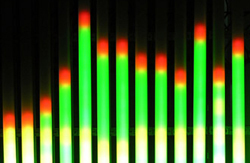Equalization (EQ) can be used to do a lot of things. Some of these things are very basic, while others are kind of exotic.
In this post, we will focus on the most typical uses for the different kinds of EQ in a pro audio/live sound environment.
Also keep in mind that as we progress into the digital age, these EQs may not be separate pieces of hardware in an equipment rack.
They may be options in a menu in a system processor, digital console, effects unit, or computer plug-in. But the function and purpose is exactly the same.
BANDPASS
1) Crossover filters and system processor settings
2) Channel strip high-pass filter (HPF)
3) Driver (loudspeaker) protection
SHELVING
1) Channel strip EQ (i.e.,3- or 4-band EQ)
2) Equal loudness curve correction (see this article on Fletcher-Munson)
3) Tone correction on instrument amplifiers and preamps
GRAPHIC
1) Ringing out monitors (feedback control)
2) System toning (see this article on Tuning vs Toning by Bob McCarthy)
3) Also used as a channel insert for more control
4) And, can be used in a compressor’s side-chain for use as a de-esser
PARAMETRIC
1) System tuning (a.k.a , “room EQ”)
2) Channel strip EQ (on more advanced consoles)
3) Feedback control in monitors or as a channel insert
NOTCH FILTER
1) Tight feedback control for monitors
2) Channel insert for precise control on a specific input
3) Group insert for precise control on a group of inputs (lavalier mics, for example)
AUTO BUSTERS
1) Extra level of feedback protection in a fast-paced stage turnover environment (such as a festival or open-mic night)
2) Channel insert on a specific input
3) Group insert for precise control on a group of inputs (lavalier mics, for example)
Caution should be exercised where it concerns auto feedback busters. There are several concerns:
The more inexpensive models and some of the earlier versions of the technology can truly do some horrific things to the sound. Yes, they may actually kill some feedback, but what else does it kill? Your frequency response, good tone, and phase response, for starters.
Just because they are so-called “smart” devices, it doesn’t mean they are. Do they know the difference between feedback and certain legitimate musical sounds? NO. In fact, any source that has a pure, steady fundamental pitch without a lot of harmonics is going to get cut by the device.
They can do a lot of things without you being aware of it. Because they auto-sense and auto-engage filters, they can do things when you’re not paying attention. And why would you pay attention? There’s probably a million other things going on at the stage that need your attention!
So because auto feedback devices can be fairly destructive, you should be cautious with them. I know a lot of the pro audio world just outright bans them from the premises. (Seriously!) If you do feel you need one, follow these rules:
1) Stick to the really good ones. Shure and Peavey units are particular standouts.
2) Use them primarily on speaking microphone inputs or groups – they seem to do a really good job there. Try to avoid using them on master monitor sends, and absolutely refuse to use them on the house mix. That’s just the wrong tool for the job.
Jeremy Carter is a veteran of the pro audio industry with extensive experience designing and operating church audio, video, and lighting systems. Learn more at Sound Sessions.























